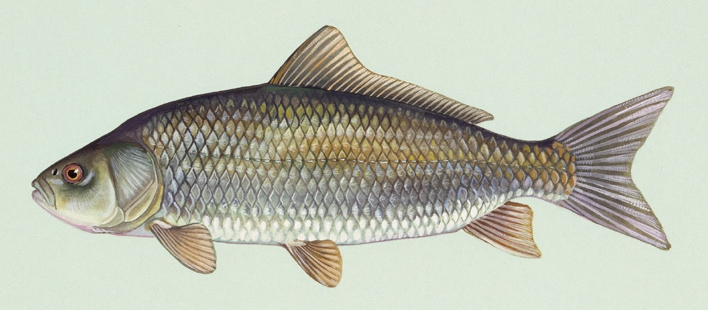- Bigmouth buffalo
Taxobox
name = Bigmouth buffalo

image_width = 250px
regnum =Animal ia
phylum = Chordata
classis =Actinopterygii
ordo =Cypriniformes
familia =Catostomidae
genus = "Ictiobus "
species = "I. cyprinellus"
binomial = "Ictiobus cyprinellus"
binomial_authority = (Valenciennes, 1844)The bigmouth buffalo, "Ictiobus cyprinellus", also known as the gourd head, redmouth buffalo, buffalo fish roundhead, or brown buffalo, is a large species of the
Catostomidae or "sucker" family.The bigmouth buffalo is a dull brownish olive color with dusky fins. Like other suckers it has a long
dorsal fin , but unlike others it has a large oblique and terminal mouth. It is the largest of thebuffalo fish and reaches a length of more than convert|4|ft|m|abbr=on and convert|65|lb|abbr=on in weight.It is distributed from the
Red River of the North Canada to theOhio River and south in theMississippi River system toTexas andAlabama in theUnited States . It lives in sluggish areas of large rivers and shallow lakes.The bigmouth buffalo migrates upstream to spawn in the spring, usually April to June where it lays its eggs on plants to which they adhere. Bigmouth buffalo, unlike its close relatives the black and smallmouth buffalos, is a filter-feeder, using its very fine gill rakers to strain crustacean zooplankton from the water. It sometimes feeds near the bottom, using short up-and down movements to swirl the water and thus be able to filter from the water the plants and animals that hover near the bottom or rest lightly on it (Pflieger 1997). More than 1 male will assit in spawning, they move the female to the top of the water,to help mix eggs and milt, spawn is usually April-May.
The fish is vulnerable in shallow water and is often captured by spearing. It is commercially caught on trot lines, setlines, hoop and trammel nets, and seines. Though it has numerous small bones, its good flavor makes it one of the most valuable of the non-game freshwater fish.
References
* "Bigmouth Buffalofish". "The Wise Fishermen's Encyclopedia", 1951 ed.
* Pflieger, W.L. 1997. "The Fishes of Missouri." Missouri Department of Conservation. 372 pp.
Wikimedia Foundation. 2010.
